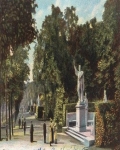Siegesallee
Archaeology »
Archaeological Monuments » Siegesallee
Siegesallee - Germany
Siegesallee is located in boulevard,Berlin.
Siegesallee monument was established on 1902.
Primary threats to Siegesallee :
It was on 27 January 1895, the 36th birthday of William II, German Emperor (1859-1941) that the Siegesallee took on a whole new meaning with the commissioning by the Emperor of almost 100 white marble statues.
Historical facts of Siegesallee :
- Siegesallee, meaning "Victory Avenue" in English, was a grand historical monument in Berlin, Germany, that showcased statues of 94 important figures from German history. Built during the late 19th and early 20th centuries, the Siegesallee served as a representation of German national identity and a celebration of its historical achievements. The avenue was located within the Tiergarten, a large park in central Berlin, and became one of the city's most prominent landmarks until its eventual demise.
- The idea for the Siegesallee was conceived by German Emperor Wilhelm II as part of a larger urban development project. The avenue was meant to be a grand procession of statues, each depicting a significant figure from the history of the House of Hohenzollern, the ruling dynasty of the German Empire. The construction began in 1895 and continued in several phases, with the final statues completed in 1930.
- The avenue was divided into two rows, with each row containing 48 statues. These figures included emperors, kings, princes, knights, and other historical personalities, such as generals, scholars, artists, and architects. The sculptures were crafted by various renowned sculptors of the time, creating a diverse and visually stunning representation of German history.
- The centerpiece of the Siegesallee was the Equestrian Statue of Emperor Wilhelm I, designed by Reinhold Begas. This massive bronze statue depicted the first German Emperor, William I, on horseback, signifying the imperial glory of the German Empire.
- The Siegesallee quickly became a symbol of national pride and heritage, with many Germans seeing it as a testament to their country's greatness and historical achievements. However, the project was not without controversy. Some critics argued that the avenue glorified militarism and imperialism, emphasizing Germany's military conquests rather than its cultural and intellectual contributions.
- In addition to the historical significance of the Siegesallee, the avenue's construction also brought about significant changes to the Tiergarten. Roads were realigned, and a section of the Berlin Wall was erected, enclosing the monument and creating a separate path for pedestrians and cyclists.
- However, the fate of the Siegesallee was ultimately tied to the turbulent political developments in Germany. After World War I, the German Empire was replaced by the Weimar Republic, and the political climate changed dramatically. The avenue's militaristic symbolism was no longer compatible with the new democratic values and aspirations of the German people.
- In 1938, during the Nazi regime, many of the Siegesallee statues were removed and stored in various locations. Some were later destroyed in Allied bombing raids during World War II. After the war, when Germany was divided into East and West, the surviving statues were scattered between East and West Berlin.
- During the division of Berlin, the Siegesallee became part of the East German territory, and the avenue's central section was incorporated into the Berlin Wall's "Death Strip." This area was heavily fortified and inaccessible to the public.
- After the reunification of Germany in 1990, the idea of reconstructing the Siegesallee was briefly considered. However, it was ultimately decided that the remaining statues should be preserved as historical artifacts rather than being restored to their original location.
- Today, the surviving statues of the Siegesallee are on display at the Spandau Citadel in Berlin. The site includes an open-air museum that allows visitors to view the statues and learn about their historical context.
- In conclusion, the Siegesallee was a grand monument that celebrated German history and national identity during the late 19th and early 20th centuries. The avenue's statues depicted prominent figures from German history and were intended to symbolize the greatness of the German Empire. However, due to political changes and the destruction caused by World War II, the Siegesallee's original significance was lost. Today, the surviving statues serve as a reminder of Germany's historical past and are preserved as valuable artifacts for future generations to appreciate and learn from.

